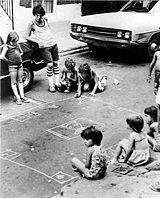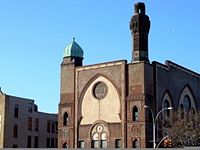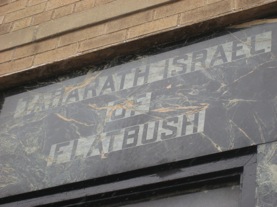Views
Midwood is a neighborhood located in the south central part of Brooklyn, NY. As seen on the map below, the boundaries of Midwood fall roughly between Prospect Park and Coney Island. Specifically, it is the rectangular geographic area between McDonald Avenue to Nostrand Avenue and Avenue H to Kings Highway.
Contents |
Early History
Midwood was settled in 1652 by the Dutch, but soon after, conquered by the English in 1664. In fact, the name Midwood originates from the Dutch word “Midwout,” meaning middle woods – a name most befitting of an area that falls right in the middle of Brooklyn. Stunningly, this area of Midwood was largely swampland and remained undeveloped for over two centuries. Only in the 1920s did Midwood see some commercial and residential development as the middle class began to move in and large apartment building and housing complexes were built.Immigration Patterns
The headline of a June 29, 2003 New York Times article by Dulcie Leimbach reads, “If You're Thinking of Living In/Midwood; Bustling Area With a Touch of Country.” Depicting Midwood as somewhat of a hidden suburban oasis in the midst of a bustling city, the article truly captures the atmosphere and identity of the neighborhood today. However, despite being “Developed at the turn of the century as an alternative to Manhattan congestion” (Leimbach, Dulcieit, If You're Thinking of Living In/Midwood; Bustling Area With a Touch of Country, 2003), Midwood represents a microcosm of the city’s diversity. Today, Midwood is a distinct area representing Chinese, Pakistanis, Haitians, Russians, and Syrian Jews, as well as a very prominent Orthodox Jewish community. Furthermore, its growth, as well as its religious and culture tolerance, show an upward trend. Midwood will undoubtedly remain a snapshot of the plethora of cultures New York City has to offer. Nonetheless, it has not always been this way.
It was as recently as the 1980s and 1990s that the Orthodox Jews moved to Midwood from Borough Park and it was even more recently that the Chinese and Pakistanis found a home there. In the 1980s, the Russians, Poles and Italians dominated the Midwood, Brooklyn area. There was then a period known as the “White Flight,” in which white skinned individuals abandoned the community in massive numbers. They were replaced in the 1990s by a flood of West Indians, Hispanics, and Hungarians.
Midwood is an embodiment of the increased diversity the United States of America has come to represent. Though a relatively small community, it boasts a varied cultural heritage. Communities all around the world would do well to take this example, breeding universal cultural exchange and taking the first small step towards world peace.
Young Israel of Flatbush
The Young Israel Movement started in 1912 as part of the Orthodox youth synagogue-center movement. It was started by Rabbi Israel Friedlander and Rabbi Mordecai Kaplan to combat the wave of assimilation by Jews into American society. Early in the 20th century, American Jews were mainly focused on advancing economically and socially. Observance of the Jewish Sabbath was rare, as were many other traditions because most jobs required working in Saturdays. The Young Israel movement aimed to provide a positive Orthodox synagogue experience for the Jews. The plan was to use the traditional communal synagogue to provide educational, religious, social, and spiritual programming.Young Israel of Flatbush Synagogue, located at 1012 Avenue I, continues to be a long and influential presence in the neighborhood. The synagogue performs services on every Saturday, as well as all major holidays. It contains a prayer room for daily prayers. It also holds a school grades one through twelve to educate Jewish youth.
Present Status
Our semester-long study on the Jews of Midwood included an analysis of the present status of the neighborhood. To complement our class work and the assigned texts, Professor Ginsberg led the class on two walking tours of the neighborhood.
Our first visit emphasized the Religious Life of the Jews of Midwood. We visited the Young Israel of Flatbush Synagogue, located at 1012 Avenue I. In the main room of the Synagogue, we saw how the room was prepared for the many service goers. Judaism, recognizing the natural urges of men, makes the seating arrangement of the main chamber of the Synagogue such that men sit in the middle section with women seated on either side, a partition blocking the view of the men. We then visited the auxiliary prayer rooms, where people could go for prayer services during the week. These rooms were much smaller than the main chamber and the walls were lined with prayer books and the seating arrangement was the same as the main chamber. Our final stop in the Synagogue was the gymnasium of the Synagogue. In the gymnasium, the Synagogue sponsors community events such as a children's basketball games.Our next stop on the walking tour was the Taharath Israel of Flatbush at 1013 E 15th Street. We were not able to enter into the building because men are not permitted to enter. Instead, we talked about the Taharath and its function in Jewish Religion. Taharath Israel is a ritual bath, which is used by Jewish women to achieve ritual purity following menstruation or childbirth.
As we made our way around the neighborhood, we saw the many stores that were very unique to the neighborhood and its inhabitants: Wig Stores for the Jewish Women who had entered into marriage and are not permitted to show their natural hair in public, a variety of Kosher Restaurants, Bakeries, Butcher Shops and Supermarkets, and also a Religious Jewish Bookstore where they sold literature for practicing Jews.
In our second walking tour around Midwood, we walked along Kings Highway. This time our walk focused on Kosher Food. We walked around the area, inspecting Kosher Certificates posted on store windows and discussing what made food Kosher. We were fortunate that, during this period, the Jewish community was undergoing preparations for the Passover Holiday. To see some of the preparations we went to the Glatt Mart, a Kosher Supermarket. We saw the different varieties of Kosher meats, spoke to the Butcher and found out how the meats were prepared. We also looked at the different varieties of food and talked about their Kosher preparations. Because of the upcoming Passover Holiday, the Supermarket had undergone major cosmetic changes. The store shelves were cleaned and lined with plastic wrap in order to ensure that Passover foods did not touch the same surfaces as non-Passover. The same treatment was given to the checkout counters at the front of the store.
Our walking tours were an integral part of our study of the Jewish Community of Midwood. They allowed us to see how the community functioned, while at the same time enhancing our understanding of the people of the area.










